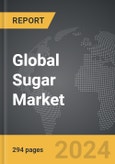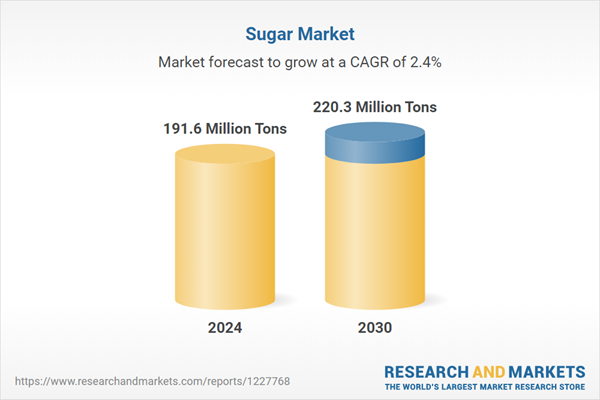Global Sugar Market - Key Trends and Drivers Summarized
Sugar, a fundamental ingredient in both culinary and industrial applications, has a storied history and a significant role in the global economy. Extracted primarily from sugarcane and sugar beets, sugar is a key component in a vast array of products, from baked goods and beverages to processed foods and pharmaceuticals. Sugarcane, predominantly grown in tropical climates like Brazil, India, and Thailand, accounts for about 80% of the world's sugar production, while sugar beets, grown in temperate climates such as those in Europe, the United States, and Russia, contribute the remaining 20%. The chemical properties of sugar make it an essential sweetener, preservative, and texturizing agent, which helps to enhance flavor, extend shelf life, and improve the mouthfeel of various food products. Historically, sugar production and trade have influenced global economic patterns and socio-political landscapes, shaping colonial empires and driving the transatlantic slave trade. Over time, the extraction and refinement processes have evolved significantly, incorporating advanced agricultural practices and industrial technologies to increase yield and efficiency, such as mechanized harvesting, improved irrigation techniques, and sophisticated refining processes that produce high-purity sugar.In recent years, the sugar market has faced a variety of challenges and shifts driven by health trends and regulatory changes. Rising health consciousness among consumers has spurred demand for low-sugar and sugar-free alternatives, impacting traditional sugar consumption patterns. Public awareness campaigns highlighting the health risks associated with excessive sugar intake, such as obesity, diabetes, and cardiovascular diseases, have led to a significant shift in consumer behavior. Regulatory actions in many countries, including sugar taxes and labeling requirements, aim to reduce sugar intake and combat related health issues. For instance, the UK introduced a sugar tax on soft drinks in 2018, leading many manufacturers to reformulate their products to avoid the tax. These regulations are reshaping the market, pushing manufacturers to innovate and adapt by incorporating alternative sweeteners like stevia, aspartame, and sucralose, which offer the sweetness of sugar without the associated calories. Concurrently, the sugar industry is exploring sustainable and eco-friendly practices to address environmental concerns. This includes initiatives to reduce carbon footprints through more efficient energy use, promoting fair trade practices to ensure equitable compensation for farmers, and developing biodegradable packaging solutions to reduce plastic waste.
The growth in the sugar market is driven by several factors. Technological advancements in agriculture and processing have enhanced production efficiency, allowing for higher yields and better quality sugar. Innovations such as genetically modified crops resistant to pests and diseases, precision farming techniques, and automation in processing plants are significant contributors to these advancements. The expanding food and beverage industry, particularly in emerging markets, continues to drive demand for sugar as a key ingredient. Countries in Asia, Africa, and Latin America are experiencing rapid urbanization and increasing disposable incomes, leading to higher consumption of processed foods and beverages that contain sugar. Innovations in product formulations, such as the development of new confectionery, bakery products, and ready-to-drink beverages, are also propelling market growth. Additionally, the increasing population and rising disposable incomes in developing countries are leading to higher consumption of sugar-rich foods and beverages. Despite the health-related challenges, sugar remains a vital ingredient in numerous products, ensuring its sustained demand. The industry's focus on sustainable practices and diversification into alternative sweeteners is helping to balance the market dynamics, meeting both consumer preferences and regulatory requirements. These factors collectively ensure the continued relevance and growth of the sugar market in the global economy, as it adapts to meet the challenges and opportunities of the modern world.
Report Scope
The report analyzes the Sugar market, presented in terms of market value. The analysis covers the key segments and geographic regions outlined below.- Segments: Segment (Sugar).
- Geographic Regions/Countries: World; United States; Canada; Japan; China; Europe (France; Germany; Italy; United Kingdom; Spain; Russia; and Rest of Europe); Asia-Pacific (Australia; India; South Korea; and Rest of Asia-Pacific); Latin America (Argentina; Brazil; Mexico; and Rest of Latin America); Middle East (Iran; Israel; Saudi Arabia; United Arab Emirates; and Rest of Middle East); and Africa.
Regional Analysis
Gain insights into the U.S. market, valued at 51.6 Million Tons in 2024, and China, forecasted to grow at an impressive 3.5% CAGR to reach 41.5 Million Tons by 2030. Discover growth trends in other key regions, including Japan, Canada, Germany, and the Asia-Pacific.Why You Should Buy This Report:
- Detailed Market Analysis: Access a thorough analysis of the Global Sugar Market, covering all major geographic regions and market segments.
- Competitive Insights: Get an overview of the competitive landscape, including the market presence of major players across different geographies.
- Future Trends and Drivers: Understand the key trends and drivers shaping the future of the Global Sugar Market.
- Actionable Insights: Benefit from actionable insights that can help you identify new revenue opportunities and make strategic business decisions.
Key Questions Answered:
- How is the Global Sugar Market expected to evolve by 2030?
- What are the main drivers and restraints affecting the market?
- Which market segments will grow the most over the forecast period?
- How will market shares for different regions and segments change by 2030?
- Who are the leading players in the market, and what are their prospects?
Report Features:
- Comprehensive Market Data: Independent analysis of annual sales and market forecasts in US$ Million from 2024 to 2030.
- In-Depth Regional Analysis: Detailed insights into key markets, including the U.S., China, Japan, Canada, Europe, Asia-Pacific, Latin America, Middle East, and Africa.
- Company Profiles: Coverage of players such as Aisin Seiki Co., Ltd., Alcast Technologies Ltd., Alcoa, Inc., Consolidated Metco, Inc., Endurance Technologies Ltd. and more.
- Complimentary Updates: Receive free report updates for one year to keep you informed of the latest market developments.
Some of the 289 companies featured in this Sugar market report include:
- Associated British Foods PLC
- CJ CheilJedang Corporation
- CSR Ltd.
- Hanseatische Zuckerraffinerie GmbH & Co. KG
- Sudzucker AG
- Syngenta AG
- Tate & Lyle PLC
This edition integrates the latest global trade and economic shifts into comprehensive market analysis. Key updates include:
- Tariff and Trade Impact: Insights into global tariff negotiations across 180+ countries, with analysis of supply chain turbulence, sourcing disruptions, and geographic realignment. Special focus on 2025 as a pivotal year for trade tensions, including updated perspectives on the Trump-era tariffs.
- Adjusted Forecasts and Analytics: Revised global and regional market forecasts through 2030, incorporating tariff effects, economic uncertainty, and structural changes in globalization. Includes historical analysis from 2015 to 2023.
- Strategic Market Dynamics: Evaluation of revised market prospects, regional outlooks, and key economic indicators such as population and urbanization trends.
- Innovation & Technology Trends: Latest developments in product and process innovation, emerging technologies, and key industry drivers shaping the competitive landscape.
- Competitive Intelligence: Updated global market share estimates for 2025, competitive positioning of major players (Strong/Active/Niche/Trivial), and refined focus on leading global brands and core players.
- Expert Insight & Commentary: Strategic analysis from economists, trade experts, and domain specialists to contextualize market shifts and identify emerging opportunities.
Table of Contents
Companies Mentioned (Partial List)
A selection of companies mentioned in this report includes, but is not limited to:
- Associated British Foods PLC
- CJ CheilJedang Corporation
- CSR Ltd.
- Hanseatische Zuckerraffinerie GmbH & Co. KG
- Sudzucker AG
- Syngenta AG
- Tate & Lyle PLC
Table Information
| Report Attribute | Details |
|---|---|
| No. of Pages | 385 |
| Published | December 2025 |
| Forecast Period | 2024 - 2030 |
| Estimated Market Value in 2024 | 191.6 Million Tons |
| Forecasted Market Value by 2030 | 220.3 Million Tons |
| Compound Annual Growth Rate | 2.4% |
| Regions Covered | Global |









